The Great Wall (tc)
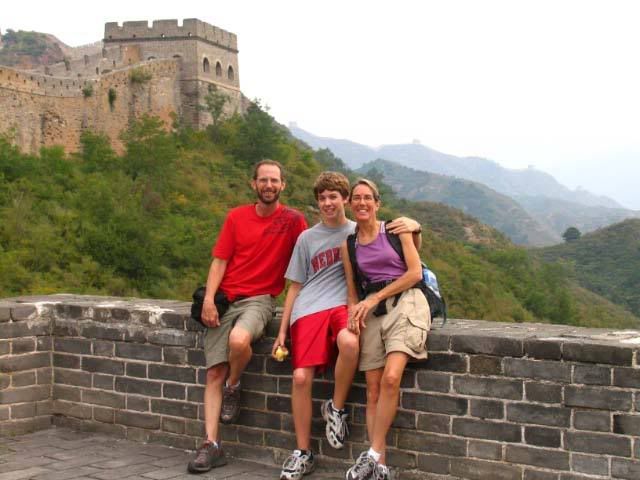
This trip was one of the ones we imagined, if in-adequately, before we left home for China. It turned out that Renee, Molly, and Dylan all had the Great Wall on their wish list, I think I might have been the only one who didn't think that way, and I now think I was the only one who was wrong in his imagination.
We left Hefei on the night train, about 10:30 or so, to arrive in Beijing about 11:00 AM. We slept soundly in the airconditioned sleeper cabin, the four of us together in one cabin unlike other trips when we weren't able to get all our berths in the same room. In Beijing our hotel room had a double bed (for Molly & Dylan) and a twin bed for us. Don't think this generous, it was more a tacit recognition that no matter how mature your highschool aged kids are they don't really take well to captivity in a single bed, little more than three feet wide. Luckily Renee and I do, once the initial drawing lines and staking territories is accomplished.
We arranged a tour with a bus company that would take us to Jinshanling about 80 miles NE of Beijing, where they would leave us to take a 6 mile hike along the wall, and pick us up four hours later at Simatai. We left our hotel at about 6:15 AM, Molly and I sat together on the bus while we wound through the early morning Beijing streets picking up more tourists for the hike. In the end we had about 20 people, notably Renee was almost the oldest person on the bus, something which I made sure to comment on. The photo here shows the bus and some of the other hikers at the end of the day
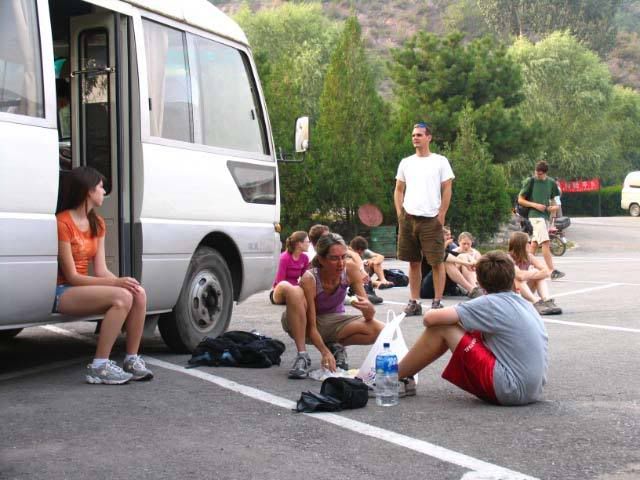
The tourists were mostly university aged, all western (French, Canadian, Swiss, American, Israelie..), something that shows how similar westerners are in what we want to see, and how dissimilar we are to the Chinese who would not take this tour. Chinese tours that we've seen are much more regimented, many tours are groups of 45 or 50 adults wearing matching hats, following leaders waiving flags distinctive for their tour and speaking into megaphones. Each tour competes with countless other tours of similarly dressed people, it is common to see tour groups line up and almost in military fashion head out into the fray to sort of attack the tourist site.
The road to Jinshanling was packed with trucks and busses, some cars, and many three wheel bicycles with loads in their trailing carts. The trip was a slow purgatory of honking and waiting and lurching. At one point we came across an accident that snarled traffic for several miles, most of it huge 18 wheel trucks, some loaded, some empty. Our driver seemed to think we had more of a reason to hurry than others so he pulled into the on-comming traffic lane and, either fast or slow, inched by the other stalled motorists. I've gotta' think that many of them felt it didn't matter - they were as happy sitting waiting as making progress. But our bus was intent on a four hour hike after a five hour drive to Jinshanling - we had no alternative. The crux of the traffic crush was a crash - two cars mangled to a horrifying extent. We doubted many would have survived, especially without air bags and seatbelts.
By noon we were in the bucolic Jinshanling village, lucky for me as we drove the five hours here I began to feel better after a rather horrible night of nausea, but poor Molly began to feel worse as we went, so that by the time we arrived at Jinshanling she was too sick to go, and I was just able to. Molly stayed with the bus driver who would move the bus down the road to Simatai. She was brave and stoic and insisted that Renee not remain with her.
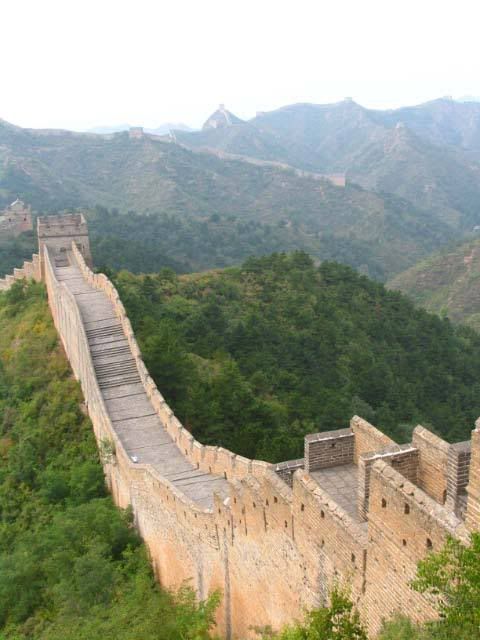
Renee and Dylan and I headed up to the Great Wall, along a stone path rising some 700 - 800 feet in elevation, arriving at last at a low entrance to the Wall. The photo above shows the state of the Wall after they have rebuilt it, within the last 20 years or so. The surrounding forests were mostly deciduous, occasional pines dotted the slopes, tree cover was not complete and the trees were all short, none taller than 30 feet high, and the majority shorter than that. Down in the steep valleys you could see small farms of corn wedged into the bottomland in fields maybe 50 feet wide and 300 feet long. Thin traces of trails linked farm to farm, and the rugged mountains stretched off into the hazy horizon in all directions.
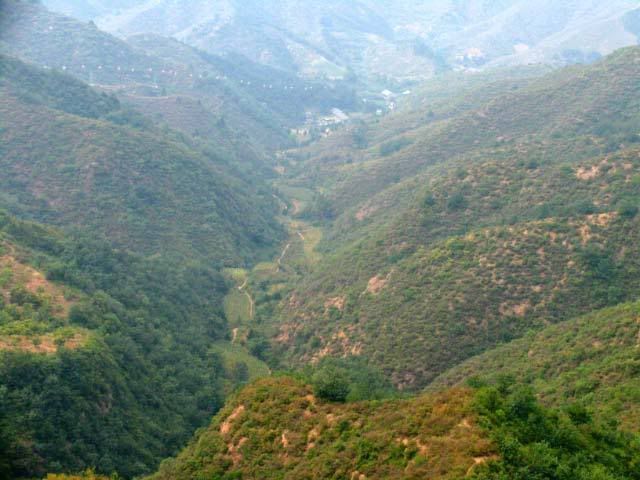
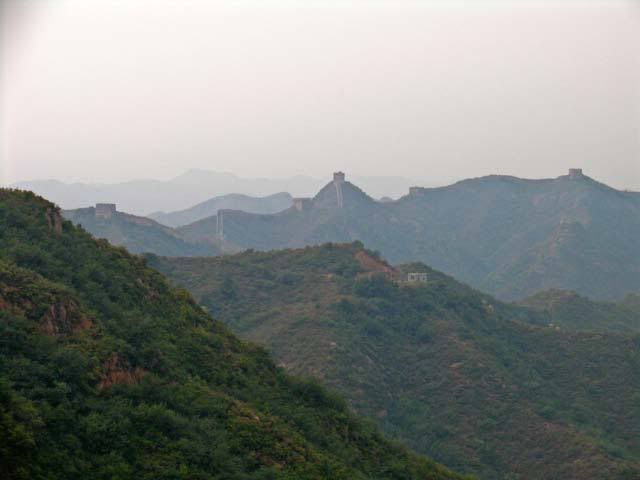
Sumac and skunkbrush were common, and a lot of the understory plants were our usual north-temperate plants that we know in the western US - dogbane, hawkweed, russian thistle, crabgrass, bristlegrass, ground cherry.. Many grew directly from the wall in cracks and crannies.
The wall near Jinshanling was restored, but after about the first mile the remainder, until just before Simatai, was in its disrepaired 500 year old state. Sights like those below show how rugged the "walk" along the wall is.
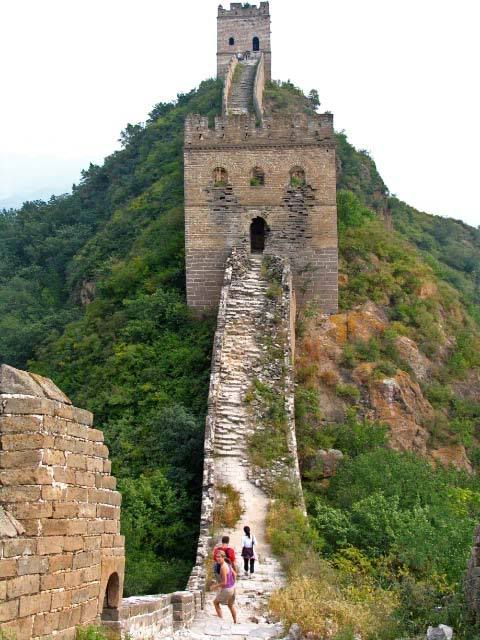
The wall consists of large stone cemented together with masonry and rises 12 - 30 feet above the surrounding land. They built the wall on extremely steep ridgelines so that the slopes accentuated the protection of the wall - the thought of breeching this huge wall by climbing up the steep slope into a hail of arrows and stones is daunting. About every 200 yards along the wall there was a defensive tower rising above the main wall, and equal in width to the wall, usually 15 - 30 feet or so. As you walk the snaking, heaving line of wall and tower there are many small summits you pass, coming after 150 or 200 ridiculously steep and crumbling steps, then giving way to an equally ridiculously steep and crumbling descent. In some places the path along the wall was 35 degrees or steeper, in some places you could (in fact you needed to) reach out and steady yourself with your hand on steps 4 or 5 treads higher than where your feet stood. As predictable as the towers spaced along the wall, and the constant up-and-downing along the ridgline, were the solitary older man or woman at the summit of fully half of these rises. Reaching the apex you were greated with "coka, water, beer..." to which we breathlessly responded by pointing at the four liters strapped to our pack.. if only we had known! I'm sure money is lighter than water. One man, below, only wanted his picture taken. I was alarmed at how tall Renee has grown since we've been here. We may need one of those beds for NBA players when we get home.
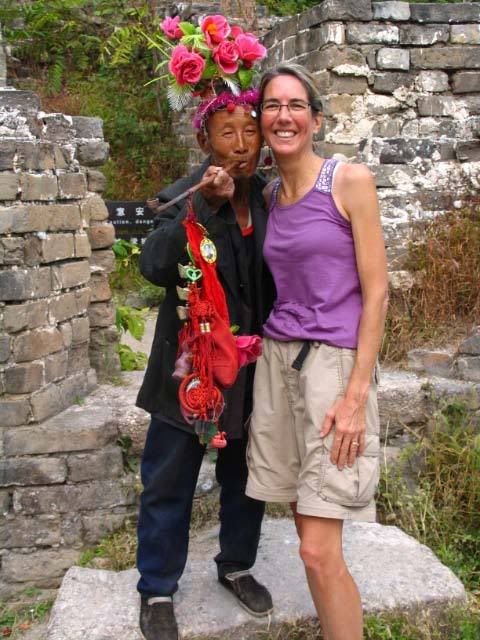
At Simatai, near the end of the hike we crossed a suspension foot bridge over a creek - the Wall doesn't cross the creeks, but instead drops steeply to the river, and you must cross by bridges adjacent. Crossing the creek we climbed back up the Wall, and took a surprise exit in the middle of the Wall to a path leading some 200 yards to a zip-line that would deposit us once again on the other side of the river. Here at the exit from the Wall, before the zip-line, there were more vendors, these close to town had more wares, and even coolers with cold drinks. One fellow sitting on the path with a comanding view over any hiker leaving the Wall had an electric megaphone and with each emerging tourist would say in english " Coka! Beer! Ice Cream!" He was obviously enjoying his megaphone, and it was a surprise to the hiker, whose ear in the quiet of the mountain air, was generally about 3 feet from the megaphone! If you didn't respond to his call he would change his intonation until you looked. It was enough for me, I sat and watched his routine for 15 minutes while Dylan did some bargaining with other merchants. The hawker with the beer was obviously reveling in the absurdity of using the megaphone when it absolutely wasn't needed. It had all the effect of coming home from work, grabbing a megaphone and announcing to your family that you are here.
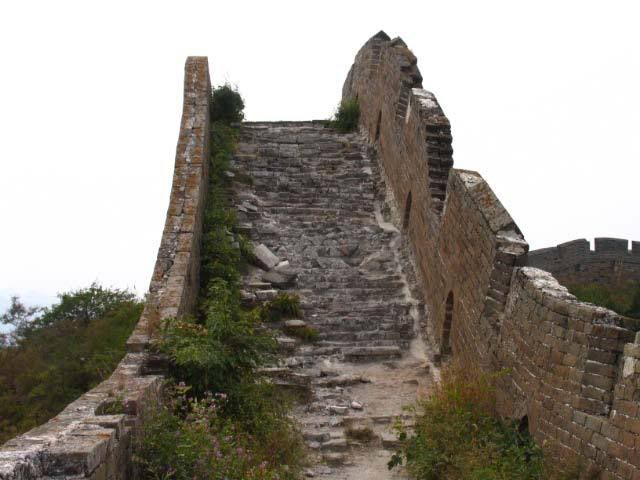
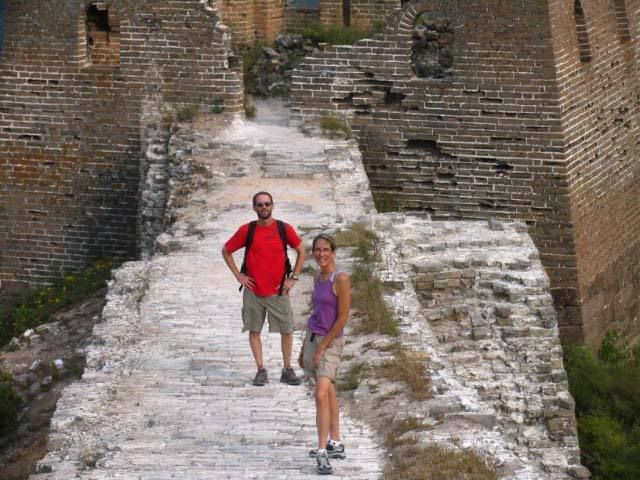
From the megaphoning hawker we walked to the zip-line, a line of steel cable probably 400 feet long on which a pully held a caribiner attached to a climbing harness. For $3.00 we got to fly across the river again, this time in the air instead of the foot suspension bridge, over high steep cliffs and open rushing water in the gorge 300 feet below.
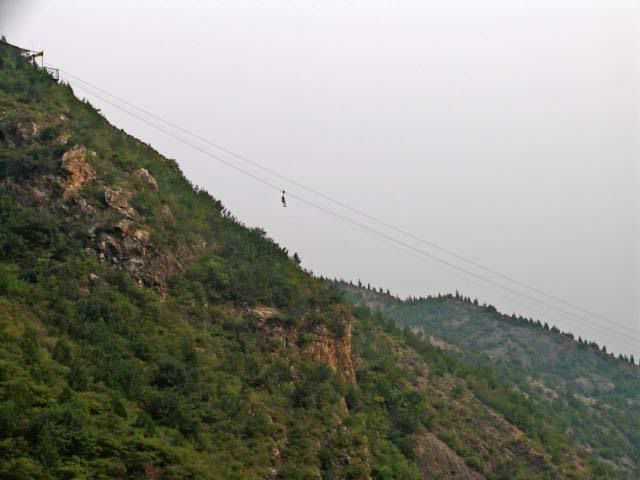
From here we took a small boat yet again across the river, now damed and forming a lake, to find Molly feeling better and sad to have missed the hike, though happy to have the great views here at Simatai.
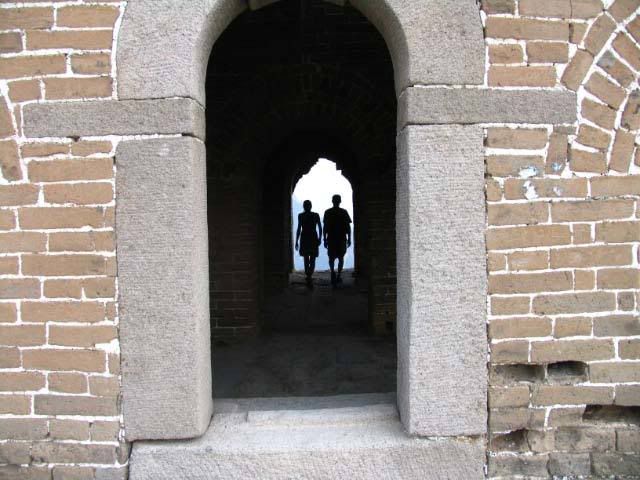

4 Comments:
Great story, Tom. Maybe you missed your calling; you could be a writer. I am also alarmed at Renee's sudden growth spurt. I fear that I may be her "little" brother again. Did any of you ride on the zip line?
Hi Tom & Renee. Well named, that wall. My back aches thinking about building that by hand. Less work than our flagstone patio...but close!
Keep the narratives coming!
Love, Brian & Diane
the wall is certainly great.. I seem to remember once that it was 3000 miles long.. that can't be right can it?.. I know its very long at any rate and you should be ashamed for not taking in the whole thing..
"something that shows how similar westerners are in what we want to see, and how dissimilar we are to the Chinese who would not take this tour." I should admit that there is an element of truth in it. :]
Post a Comment
<< Home